Search Results for 'freer'
Did you find what you wanted ?
Tue 8 Nov 2022
Posted by Steve under
Reviews1 Comment
REVIEWED BY DAVID VINEYARD:
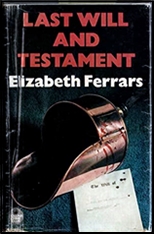
E. X. FERRARS – Last Will and Testament. Virginia & Felix Freer #1. Collins, UK, hardcover, 1978. Doubleday, US, hardcover, 1978. Bantam, US, paperback, 1981. Felony & Mayhem Press, US, softcover, 2021.
“I’m growing wise in my old age. I don’t like taking risks anymore.â€
“I wish I could believe that.â€
“You don’t, you know. You don’t care in the least.â€
“Not very much, perhaps, because the truth is I simply don’t believe you.â€
Virginia Freer has returned home after a long night at the bedside of her dying friend Mrs. Arliss, who passed with a stroke hours earlier, and who should she find stretched out on her sofa but her charming ex Felix who let himself into the house worried because Virginia was out of place.
Virginia long ago saw through Felix and while not divorcing him has removed herself from his charming but inevitably criminous lifestyle (his latest scheme a racket involving selling dubious automobiles).
“…we’ve always remained the best of friends,†he said,…“No need to quarrel just because it happened not to work out too well, living together.â€
Virginia only wants a bath and food and for Felix to go away. She has had a long night and has some unpleasant phone calls to make to Mrs. Arliss surviving relatives. It’s all a bit tiresome, but Felix does make good coffee, and comes bearing an unwelcome gift, that this time he seems to have bought and not pilfered.
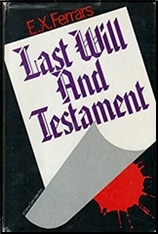
Virginia has a wary eye for Felix. She has her own money, comfortable but not wealthy, a home in the village where she grew up, and a career at a nearby clinic as a physiologist.
Felix showing up just seems a minor annoyance, but whenever Felix is around… And sure enough it turns out the late Mrs. Arliss much coveted estate is gone and no one is inheriting anything. Felix is still hanging around preparing a meal for her when Virginia returns with Meg Randall, Mrs. Arliss companion who just revealed her employers money is gone, gambled or hidden away.
Then during the funeral some valuable minatures go missing from the Arliss home and Virginia starts wondering why Felix showed up to see her in the first place at just that moment. Even if he didn’t take them, is he involved? It looks bad because he not only knows Mrs. Arliss’s former servants the Bodwells, they are at his flat in London when Virginia shows up there.
Well, he’s Felix, of course he’s involved… Isn’t he?
I thought mainly of Felix, feeling the depression that I always did after any meeting with him. It was always so tempting to believe what he said. It promised such comfort and peace.
Elizabeth Ferrars whose editor suggested the E. X. pseudonym was a successful mystery writer whose novels were mostly non series mysteries in the classical mode though she had several series characters including Toby Dyke, and with Andrew Bassett, and the Freers late in her career. Her mysteries tend to be fast moving, smart, and well plotted with attractive characters and well plotted solutions. Her heroines tend to be intelligent and self sufficient and she downplays violence and bloodshed in favor of plot and wit.
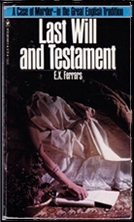
1978’s Last Will and Testament was the first Freers novel and a lively introduction to the two charming protagonists.
Things take a darker turn when the miniatures are returned and one of the heirs in murdered. When the Bodwells are murdered too Felix decides to intervene and from there on it’s a straight murder mystery, just complex enough to keep things interesting and with more than enough charm and wit with Ferrar’s easy unobtrusive but slick style keeping us guessing and the action neatly moving until the crime is solved and Felix almost the hero of the day.
The Freers continued to adventure in much the same manner from 1978 to 1992 in a series of light and well written adventures that managed to be quite modern while still echoing some of the fun of an earlier time. This was my first time encountering the pair, but I can assure you I will spend more time with Virginia and Felix, though in Felix’s case I may check my wallet afterward.
Thu 31 Dec 2020
Posted by Steve under
Reviews[2] Comments
E. X. FERRARS – Frog in the Throat. Doubleday/Crime Club, US, hardcover, 1980. Bantam, US, paperback, 1981. Published earlier in the UK by Collins, hardcover, 1980.
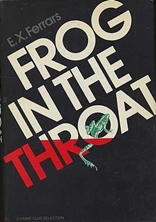
Although E. X. Ferrars has been writing mysteries for over forty years, she’s nowhere as well-known as she should be. One big reason I can see for that is that since her first five books, until very recently has she not used a series character of any kind. (And of Toby Dyke, who has not been heard from since 1942, I know nothing at all.)
Where would Christie have been without Poirot or Miss Marple? Ingenious mystery plots may be totally fine in the abstract, but unfortunately they just don’t grab the reader’s attention in the bookstore.
There is a bare chance – but don’t count on it – that Virginia Freer’s errant ex-husband Felix, who has appeared at least one time before, may return again and “solve” another case. He slips in and out of her life with such casualness that it is not a foregone conclusion that he will. Nor is his idea of finding a killer a very useful one for the police.
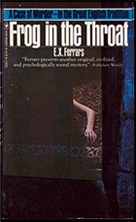
Dead is a writer of historical novels, on the night of her engagement party to poet Basil Deering, who is the murderer’s next target. Or are there two murderers? A bigamous marriage some years in the past seems to be the crux of the matter, as well as some other more recent romantic entanglements, and a bit of injudicious blackmail.
The ending is vaguely unsatisfying. Perhaps just a bit of a letdown. I think it’s because it’s clear that the police this time are perfectly capable of solving the murders by themselves, without the odd couple assistance of Mr. and Mrs. Freer.
On the other hand, while the fuss they generate may not have been wholly necessary, it is nonetheless a fascinating and wholly absorbing sort of fuss. (And why else do we read mysteries?)
Rating: B
–Very slightly revised from The MYSTERY FANcier, Vol. 5, No. 2, March/April 1981.
The Virginia (& Felix?) Freer series –
Last Will and Testament (n.) Collins 1978.
Frog in the Throat (n.) Collins 1980.
Thinner Than Water (n.) Collins 1981.
Death of a Minor Character (n.) Collins 1983.
I Met Murder (n.) Collins 1985.
Woman Slaughter (n.) Collins 1989.
Sleep of the Unjust (n.) Collins 1990.
Beware of the Dog (n.) Collins 1992.
Mon 7 Oct 2019
SELECTED BY DAVID VINEYARD:
FRED M. WHITE “The Scrip of Death.” Short story. Dr. Victor Colonna #1. First published in Pearson’s Magazine, London, July 1898. Collected in The Last of the Borgias: Being the Strange History of Victor Colonna, Professor of Science,and his Experiments in the Lost Art of Poisoning., hardcover, 1898? Reprinted by The Battered Silicon Dispatch Box, softcover, date? [Announced; may have never been published.] Available online here.
“You want me to use my method to murder someone?â€
“To be perfectly frank with you, I do.â€
The lady making the request is the beautiful Ellen Longwater, who claims her wealthy and famous family is in danger of ruin, and the man she has made the request of is none other than Dr. Victor Colonna, who has just given a lecture on his discovery of the rarest of all tomes, the poison book of none other than Lucretia Borgia (before history revealed she was more victim than monster), meaning, according to his own lecture, that he is master of poisons unknown to mankind, capable of bringing nations to their knees if he chose, and a veritable judge, jury, and executioner no court could hope to prove anything on thanks to his undetectable poisons.
Of course Dr. Colonna was only speculating. Ellen Longwater is serious.
Fred M. White was one of the most popular and prolific writers of the period, his name as well known on magazine covers as Conan Doyle, and his stories encompassed multiple series including adventure, mystery, secret service, and early science fiction. He particularly did well in the then popular disaster genre of which Conan Doyle’s Professor Challenger story “The Poison Cloud†is one of the better known examples today.
But Victor Colonna is surely the oddest detective hero anyone ever came up with, sleuth and avenger but far from the clean cut way of most British heroes, and the six long stories comprising the “Last of the Borgias” series are among the oddest of their kind, with Colonna one of those late Victorian supermen who are above mere law, a long haired aesthete with a no compunction about making God like interventions in the lives of mere mortals.
To be fair to White and the genre, it wasn’t until Ellery Queen in The Door Between that anyone seemed to bring up the question of what all this God like behavior might lead to in classic detective fiction. Before then other than an occasional insight the brilliant sleuth’s mere existence seemed to justify his actions, even if Peter Wimsey wept over the execution of the man he sent to the gallows, he didn’t question his right or duty to do so.
And to ruffle feathers further these stories violate the heck out of Detection Club Rules about “poisons unknown to science.†Dr. Fu Manchu could take a hint or two from Dr. Colonna.
This being the Victorian age Dr. Colonna doesn’t hesitate to come to the aid of a lady in distress:
“I am prepared to sign a document which you will draw up, fully implicating myself. You may regard me as a madwoman—to all practical purposes I am. It makes me mad to see our ancient family, our prestige and money and influence in the throttling grasp of a scoundrel! Unless something is done, Count Henri Felspar will destroy us.”
“Oh, then Felspar is to be my victim!”
“Yes, yes. You speak as if you knew him.”
“By repute I know him very well indeed,” Colonna replied. “Felspar is a man of science like myself. He enjoys a high reputation.”
So in his first case, Colonna is already up against a veritable Moriarity, though I have to say Felspar is a particularly thud ear name for a super villain. I suppose he could have named him Yardarm instead..
Colonna assures us Felspar is a “bad un,†a brilliant chemist, but a blackmailer and worse, and his plot to marry the Princess Esme of Valdamir (names of people and places in this one aren’t White’s strong suit) not only threatens the happiness of Ellen Longwater’s son who also hopes to marry her, but also the fortune and fate of a great family because Felspar can prove Ellen’s son is not the heir to a great family he claims and destroy his hopes with Esme.
You can almost imagine Victorian era audiences booing Felspar as they read. How dare a dirty foreigner interfere with a handsome young Englishman defrauding a foreign Princess.
How Colonna confronts Felspar, and ultimately removes the Count as a threat frankly isn’t worth the build up. White writes well enough, but basically once Colonna accepts the commission to rid the family of Count Felspar the story grinds to a halt.
There is some artificial suspense at a public gathering while the Count reads his prepared revelation and Colonna softly counts down to the moment Felspar falls victim to the poison, then a frankly anti-climactic reveal of how he administered the poison (not only unknown to science, but so mysterious we don’t even get a hint of what was in it — at least Fu Manchu used spider and snake venom) and used simple misdirection to steal the revealing papers in the dead man’s pocket.
To be frank, by that point I was imagining Sherlock Holmes, Dr. Thorndyke, or Father Brown feeling quite content to have sent our hero to the gallows. Somehow this sort of thing was much more satisfying when the Saint disposed of a total rotter with a bit of cleaning fluid on his tie, or Bulldog Drummond snapped his neck. Nor does the not so subtle jingoism and xenophobia of Colonna using nasty Italian poisons, appearing quite foreign, and having an Italian name escape the modern reader.
It’s no wonder there was only one series of adventures for Dr. Colonna, just reading the first one leaves the reader in need of a shower.
Complete contents of The Last of the Borgias. All are Victor Colonna stories:
The Scrip Of Death
The Crimson Streak
The Holy Rose
The Saving of Serena
The Varteg Necklace
The Three Carnations
Thu 17 May 2018
SELECTED BY DAVID VINETARD:

B. M. BOWER “The Spook Hills Mystery.” Popular Magazine, November 7, 1914. Published in hardcover as The Haunted Hills, Little Brown, 1934, and in paperback by Popular Library, #306, 1951. Also available online here, among other websites.
“The Spook Hills Mystery” begins rather tritely with the arrival of young Easterner Shelton C. Sherman with a typically cantankerous old hand named Spooky (Gabby Hayes before there was one, “He was not a bad sort, though he was an awful liar when the mood seized him…â€) who leads him on about the “ghost†of Spook Hills, but then popular Western writer B(ertha) M(uzzy) Bower, creator of Chip of the Flying U and a long series about that outfit, throws us a curve.
This, as a beginning, may sound a bit hackneyed. Since the first story was told of the West, innocent young males have arrived in first chapters and have been lied to by seasoned old reprobates of the range, and have attained sophistication by devious paths not always unmarked with violence. But when you stop to consider, life itself is a bit hackneyed.
At least she noticed, and it is far from the only curve in this tale.
Sherman, soon to be known as Shep, is greener than the greenest greenhorn who ever lived, and about to join the Sunbeam Outfit (in “that part of Idaho which lies south of the Snake …â€) to make a man out of him at the hands of Aleck Burney, who has a way of putting youngsters “on the fence†to make “men†out of them in the time-honored way of obnoxious bullies who are supposed to be makers of men in popular fiction from time immemorial. Never let it be said Ms Bower ever missed a cliché when one was at hand (enter Wallace Beery, or the older John Wayne, making men by breaking their spirit since time began).
Shep’s parents have sent him West, all pretty 6’ 2†of him: “… to get some width to go with my length: Dad’s an architect. He said he’d have to use me for a straight edge if something wasn’t done pretty soon.”

The Sunbeam Ranch itself is harbinger of “a keen sensation of disappointment,†otherwise little more than a dirt shack seen over by the giant Burney, who typically tries to establish dominance first thing by a crushing handgrip. Give old Shep this, it hardly bothers him.
Soon he starts to get the hang of things, and they brighten a bit when he meets Vida, daughter of Sam Williams and niece of Uncle Jake and part of a sheep herding outfit, and that should tell you a bit about where this is going, though it is hardly enough, because that is another of Bower’s curves.
Bower knew a great deal about life on a ranch, in fact too much for her readers’ own good, since some of her books spend more time on the drudgery and boredom of actually living on and running a ranch than any good Western can take. Realism combined with a certain Polyannaish view and too few doses of adventure and melodrama makes for an uncertain read for many. For all her beautifully described scenery and realistic views of frontier life you can find yourself wishing Max Brand would show up and kick a few doors down. You wish a few of those “Gosh Darn†moments were at least “Gol Dangs.â€
This one is made of sterner material than that though, and soon Shep has gotten a glimpse of Spooky’s Spook, a critter that leaves a footprint like a bear, if a bear was big as an elephant. Of course we all know he can’t leave that alone any more than he will the feud building between the Sunbeamers and the sheep herders.
And he certainly doesn’t leave bad enough alone, tracking the “thing†to a tunnel where, “The terrible silence was split suddenly by a scream. Human, it sounded, and yet not human, but beastly — horrible. Shelton dropped the candle and clung to the rock beside him. His heart, he thought, stopped absolutely. His very knees buckled under him while he stood there. And then he heard something running, somewhere, even while the cave was playing horribly with the echoes of that scream. Running down that other passage with long leaps, it seemed to him, and the beat of four padded feet upon the rock floor.â€

Where’s Sherlock Holmes when you need him, or for that matter Allan Quatermain? From an Indian woman Shep learns Burney’s father was killed by a “big bear†in Montana, which might explain why Burney objects more to his hunt than his friendship and budding romance with Vida, it also makes it unlikely the sheep killer preying on the Williams herd is Burney. Shep has a mystery to solve.
Then Uncle Jake is killed in the sheep camp while Burney is away in Pocatella, though the herders don’t believe it, and Vida wants his blood.
“I find,” replied the coroner, “that the deceased undoubtedly came to his death by having his neck broken by twisting. Four ribs were broken also, evidently by crushing. There are no bullet wounds — the only other marks of violence on the body being some scratches on the scalp behind the ear. These, I judge, were made by finger nails, in gripping the head to twist it.”
Burney is free. He never made the prints the jury viewed. When the wagon where Vida sleeps is attacked in the night and she hears: “a hoarse scream …. Human—and yet not human—mocking, maniacal, horrible. The most awful sound that Vida had ever heard in her life; a squall, a cry — a shriek she could not find a name for. Her memory flew back to the tales of ghosts and demons that an old Scotch woman had told her years ago. Warlock — that was it! A warlock, such as Maggie MacDonald had told about, that haunted the heath behind the village where strange deaths occurred periodically in the dark of the moon. When men and women were found strangled — and none knew how or why.†And then Vida sees the creature pursuing one of the herders, “the huge figure of a man who came on with
giant strides, leaping clean over what bushes came in his way.â€
And then, and then … Shep drops entirely out of the picture. One of the cowhands, Spider, takes up with Vida, they solve the mystery, and all Shep gets is a letter home, while Spider gets the girl.
Uh, wow.
The action is everything you could hope for and Bower handles the atmosphere and building sense of danger and threat with the skill of a pro. Some of the passages describing the country and the setting border on beautiful, and for all the Western lingo, it’s not too trying, to this reader at least. If the rather juvenile saga of the Flying U is all you know of Bower’s Westerns, this one will clear your sinuses, it’s a humdinger.
Tue 28 Mar 2017
Posted by Steve under
Authors[3] Comments
THE LOST BOOKS OF PETER CHEYNEY, Part One
by Keith Chapman
My email traffic has been buzzing with Peter Cheyney messages, both “to” and “from.”
UK bibliographer Steve Holland of the Bear Alley blog, which has in the past run several lengthy posts about this hugely successful author of thrillers in the 1940s and ’50s, recently wrote to say: “Amazing to see all these forgotten works by such a major author turning up.”
Now available at Roy Glashan’s freeread.com.au (a Project Gutenberg offshoot) is The Deadly Fresco, which made its first appearance as a newspaper serial in Australia in 1932.
In Roy’s pipeline are several more such full-length works, written as much as eight years prior to publication of the “first” Cheyney novels recorded at Wikipedia, the Thrilling Detective website, the Official Peter Cheyney website, etc.

Just a few days ago I told Roy about The Sign on the Roof, serialized in the Auckland Star from September 14 to October 5 in 1935, and about Death Chair serialized in the New Zealand Herald from May 21 to July 16 in 1932. (Very incidentally the NZ Herald was the first paper I worked on after arriving here in 1967, and I was an Auckland Star sub-editor at the time of its closure in 1991.)
Roy replied, “I wasn’t aware of the existence of this novel [The Sign on the Roof]. ”
Steve Holland found an advertisement in a British newspaper announcing serialization of Death Chair in the Sheffield Mail in 1931. It said, “Mr Peter Cheyney is already well known to Sheffield Mail serial readers who remember his splendid stories The Vengeance of Hop Fi and The Gold Kimono.”
Both these serials were also syndicated and ran in Australian and New Zealand newspapers, such as the Auckland Star and the New Zealand Herald. Digital image files can be seen at PapersPast, a website of the National Library of New Zealand.
Roy tells me he has ebook versions of the pair in the pipeline for his RG Library at freeread.com.au. The Vengeance of Hop Fi‘s first appearance that he knew of was the serialization in the Auckland Star beginning on July 7, 1928.
The FictionMags Index has novella, presumably abridged, versions of the Hop Fi and Komino stories listed under the pen-name “Stephen Law” and published in 1937 in single issues of the Amalgamated Press’s Detective Weekly. FictionMags also lists a newspaper serialization of The Sign on the Roof in The Hawick News (Scotland) in 1935.
Whetting my reading appetite for these well and truly forgotten books, not known to have been in print since the 1920s and ’30s, is this quote from the NZ Herald:
“The Death Chair is an astounding story told by a great writer in his most brilliant form. It is drama, pathos, humour, a story that captivates the minds of all who read.”
Note: Part Two of this two-part article appears here.
Mon 16 Nov 2009
A 1001 MIDNIGHTS Review
by Marcia Muller:

E. X. FERRARS – Frog in the Throat. Doubleday Crime Club, US, hardcover, 1980. US paperback edition: Bantam, 1981. British edition: Collins Crime Club, hc, 1980.
Virginia Freer, heroine of Frog in the Throat, is staying with craftsmen friends Helen and Andrew Boscott (he’s a furniture restorer, she’s a weaver and tapestry worker) for a much-needed holiday.
On a quiet afternoon, in walks the big mistake of Virginia’s life — Felix Freer, her estranged husband. Felix is one of those charming people who have few scruples and an overwhelming capacity for lying — even when he thinks he’s telling the truth. He is now lying about his reasons for dropping in at the Boscott house, and Virginia wonders why.
The events of the evening only complicate matters. At a neighbor’s cocktail party, novelist Carleen Fyffe (half of a famous sister team of historical-romance writers) announces her engagement to poet Basil Deering (whom Felix has expressed an interest in meeting).

Shortly after the Freers and Boscotts return home, Olivia Fyffe arrives, saying she has found her sister on the floor of their den, murdered.
When they all go to the Fyffe cottage, however, there is no body. Almost everyone thinks Olivia is being dramatic for some reason of her own, or perhaps hysterical. It takes a second body and the discovery of her sister’s corpse to prove otherwise, and a certain amount of detection on Virginia’s part to determine Felix’s connection with the murders.
The pace of this novel is slow, with good characterization of all participants except the heroine. The plot unfolds in the best tradition of the British country-house mystery, with plenty of suspicion and all ends tied up nicely at the conclusion.
One wishes, however, that Virginia Freer were as well characterized as her enigmatic and complex husband and hosts. It is a little hard to care what happens to any of them when the viewpoint character is so lacking in substance.

Ferrars has been writing mysteries for over forty years; many of her tales are set in such locales as Greece, Africa, Mexico, and Australia, as well as in England. Other notable titles include Give the Corpse a Bad Name (1940), Hunt the Tortoise (1950), The Busy Body (1962), The Seven Sleepers (1970), The Cup and the Lip (1976), and Crime and the Crystal (1985).
———
Reprinted with permission from 1001 Midnights, edited by Bill Pronzini & Marcia Muller and published by The Battered Silicon Dispatch Box, 2007. Copyright © 1986, 2007 by the Pronzini-Muller Family Trust.
Tue 7 Oct 2008
Posted by Steve under
Reviews1 Comment
A REVIEW BY MARY REED:
ISRAEL ZANGWILL – The Big Bow Mystery.
Henry, UK, hardcover, 1892. Rand McNally, US, hardcover, 1895. (The latter is shown.) Reprinted often, either alone or in various anthologies, including the following (all shown): W.B. Conkey Company, US, hardcover, 189? Three Victorian Detective Novels, edited by E. F. Bleiler (Dover, trade pb, 1978). Great Detectives: A Century of the Best Mysteries, David Willis McCullough, editor (Pantheon, US, hc, 1984).

The Big Bow Mystery opens on a frigid, foggy December morning as the Dickensian-named Mrs Drabdump, a widow letting out rooms in her home in Bow, east London, cannot get lodger Arthur Constant to open his bedroom door. She becomes so alarmed she goes to ask for help from George Grodman, a retired detective who lives a few doors down the street, and he forces the door open.
The horrible sight within is described by the coroner as “the deceased lying back in bed with a deep wound in his throat… There was no trace of any instrument by which the cut could have been effected: there was no trace of any person who could have effected the cut. No person could apparently have got in or out.”
Needless to say the case causes a sensation, the more so as Constant, though wealthy, was devoted to helping the working class.

Fellow lodger and friend Tom Mortlake, a man of similar mind and “hero of a hundred strikes”, had left early that morning for Devonport Dockyard to help the dockers there. A second sensation is caused when Mortlake is arrested at the Liverpool Docks where he was making enquiries about steamers to America.
He is released when it is learnt he was in Liverpool to seek news of a friend about whom he was uneasy. His innocence is supported by a cabby who drove him to London’s Euston Station that morning, who confirms he picked up Mortlake at about 4.30 am, well before the estimated time of Constant’s death. Even so, more doubts are raised when Mrs Drabdump reveals at the inquest that Mortlake and Constant had quarrelled the night before the latter’s death.
The retired detective Grodman and Edward Wimp of Scotland Yard both undertake investigations and so the deciphering of The Big Bow Mystery begins. To add a bit of spice to the teacake, the men detest each other.
In the course of a lengthy narrative we hear of Denzil Cantercot, a poet with secrets — why he gives money he’s just received to two housemaids before it’s even warm in his pocket for example — and Mortlake’s fiancee, Lucy Brent, who has apparently disappeared.

There’s some plot padding, which is not to say the story is uneventful: Gladstone appears at an event that ends in a riot and ultimately Mortlake goes on trial for the murder of his friend. But did he really do it and if he did, how it is to be proved?
My verdict: One of the burning questions in The Big Bow Mystery is how the culprit carried out the crime, given the bedroom door was not only locked but also bolted on the inside.
Various theories are suggested in letters to the press, including a monkey with a razor coming down the chimney, the removal and replacement of a window pane or a door panel, a culprit hiding in the wardrobe who managed to escape unnoticed when the door was broken down, and secret passages and trapdoors!
As for the missing weapon, was it a candlestick or similar common item of bedroom furniture, fitted with a hidden blade after the fashion of a swordstick — or could the departed have been a suicide and somehow swallowed the weapon before expiring?

After various red herrings are thrown back into the briny and trips into investigative cul de sacs are reversed, the culprit turns out to be the least likely suspect, who committed the crime for a particularly vile reason.
The explanation of how a murder could be committed in a locked room is clever, hinging partly on the physical arrangements and partly on a psychological point, the clew to which is given in fair fashion early in the novel.
If readers don’t mind Zangwill’s somewhat rambling and wordy style The Big Bow Mystery will be of interest. Published in the early 1890s, well before the beginning of the Golden Age, it is also said to be the earliest true example of the locked room mystery.
http://freeread.com.au/ebooks/c00062.txt
Tue 22 Jul 2008
A REVIEW BY MARY REED:
MELVIN L. SEVERY – The Darrow Enigma. Dodd Mead, US, hardcover, 1904. Grant Richards, UK, hardcover, 1904. Copp Clark, Canada, hardcover, 1904 (the cover of this edition is the one shown below).
The Darrow Enigma is narrated by an unnamed doctor, consulted by chemist and lawyer George Maitland for a bit of a nerve tonic. They become friends, for the narrator is greatly interested in science, and it is through this friendship that our anonymous physician becomes involved in the case.
Ultimately Maitland confesses the real reason he visited the medical man is because he is the Darrow family’s physician, and Maitland has fallen for Gwen, daughter of the house, and wishes to be introduced. Needless to say Gwen is beautiful even though, whisper it quietly, she does not imprison herself in corsetry.
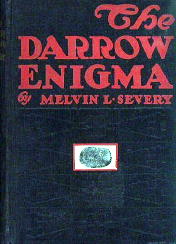
Well, then, an introduction to the young lady is effected and it is while the two friends are visiting the Darrow household and Gwen is appropriately singing “In The Gloaming” as dusk falls when her father John clutches his throat, cries out he has been murdered, and dies.
Yet there is nobody in the room other than the Darrows, Maitland and the doctor, and two other visitors. How then was it done?
The doors into the room were closed or locked, the only open window was perhaps six inches ajar and locked in that position and John Darrow was sitting in a high-backed chair over eight feet from it in any case, plus there were no niches or cupboards or curtains behind which the unseen assassin could hide.
Or was it suicide? Either way what was the weapon and where has it gone? To find out the police bring in three investigators: Mr. Osborne, Mr. Allen, and French-born Louis Godin, now reportedly the best detective in the U.S.
And so begins a tale with a dab of woo woo and a touch of gothic. John Darrow had had dreams foretelling he would be murdered, as a result of which Gwen makes him a certain promise that will later cause romantic havoc.
It is established there’s a connection to India long ago — though it is nothing to do with gems stolen from Indian temples — and Maitland steams off to pursue investigations there. After that he is off to San Francisco to find and interview a couple of Darrow’s former servants, who are Chinese and so, we might say, automatically suspect.
There follows a series of Strange Coincidences involving Anthony and Cleopatra, leading to what can only be described as a brilliant piece of deductive reasoning — involving reading detective novels! — that puts them on the track of certain parties of interest.
The culprit is brought to trial but is it the right person? Was the murder committed by the bizarre method the man on trial describes? What about the motive?
My verdict: First, the method employed is one that fits a clue hidden in the text, though I must say that more clues are needed so the reader can deduce the culprit. There are red herrings and side trips and everything seems to fit together very well until the final confrontation in the court room when the entire case is turned upside down.
Thus The Darrow Enigma is a bit of a mixture, though unlike the proverbial curate’s egg, on balance I would give it a nod rather than a frown since, despite the weakness mentioned, I found this novel enjoyable enough and the weapon utilised so outrageous and yet simple that points must be awarded on that alone!
In an aside, I was intrigued by Severy’s description of the eavesdropping device employed at an important point and consulted an electrical engineer about it. He said theoretically it was possible but the technology was not up to it at the time.
However, invention of this gizmo is not surprising as Severy held at least 90 patents. His fictional bugging device involves a piece of burnished silver fastened to a diaphragm, a small beam of light trained on the silver being reflected onto a sensitised moving tape photographically registering movement of the diaphragm for later conversion to an ordinary record.
Needless to say the result is a vital piece of evidence.
Etext: http://www.freeread.com.au/ebooks/c00040.txt
[BIBLIOGRAPHIC DATA] Taken from the Revised Crime Fiction IV, by Allen J. Hubin:
SEVERY, MELVIN L(inwood) (1863-?)
The Darrow Enigma (Dodd, 1904, hc) [George Maitland; Boston, MA] Richards, 1904.
-Fleur-de-Lis and other stories (Boston, MA: Esoteric, 1889, hc)
Maitland’s Master Mystery (Ball, 1912, hc) [George Maitland]
The Mystery of June 13 (Dodd, 1905, hc) [George Maitland] Stevens, 1905.
[UPDATE] 07-23-08. Here’s an email I received from Victor Berch this afternoon:
Steve:
On your blog, there was an entry for Melvin Linwood Severy taken from CFIV as 1863-?.
I’m assuming that by now Al may have his death date and other tidbits about him. But just in case,he was born in Melrose, MA Aug. 5, 1863 and died in CA on Oct. 12, 1951. He was an engineer, musician, an inventor and author. He was married to Elizabeth Ann Flint, born in Jackson, MO.
Most of this was verified on his passport application for travel abroad. Google has lots to say about him as an inventor. (Follow the link for one such page.)












